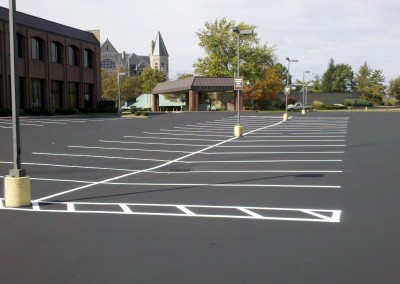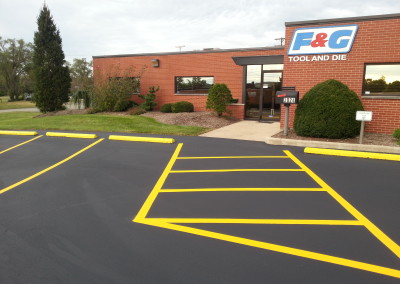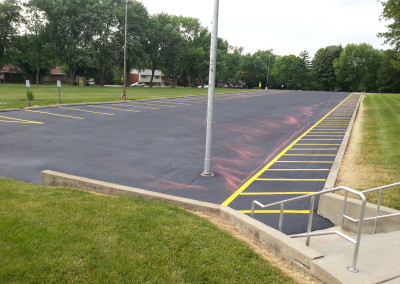Parking Lot Sealcoating
Sealcoating is one of the most important elements of a pavement management plan.
What is sealcoating?
Sealcoating is the process of applying a product to the surface of the asphalt that fills the pores to protect against water, chemicals, and the elements that erode the surface, give a consistent black color to a faded out parking lot, and provide an anti-slip surface for safety. Why should you sealcoat? To protect the surface of the asphalt from erosion and to enhance or compliment the appearance of your home or facility. When should the asphalt be sealcoated? New asphalt. When asphalt is first installed it is very porous, and thus more vulnerable to erosion from water, oils, gasoline, etc. So, it is imperative to seal the pores of the asphalt no sooner than 90 days of installation. You need to wait to seal new asphalt until the oils in the new asphalt have dried out. These oils prevent the sealer from bonding and prematurely wear off. Existing asphalt that’s never been sealed is even more important to be sealed than new asphalt, the older it is. The same reasons apply, as they do to new asphalt, but are more imperative due to the deterioration of the binder that has taken place that make the asphalt even more porous than when it was new. Asphalt that’s been sealed before needs to be re-sealed on a regular basis, depending on traffic, simply because the sealer wears off over time because of traffic, snow plowing, salts, chemicals and from the sun exposure. What product should be used? We use Brewer Cote, a coal-tar based liquid emulsion product, to seal the surface of asphalt. Our sealer is fortified with 3 lbs of silica sand per gallon of sealer offering an anti-slip surface and increased durability. As well we mix in Tarmax, a latex fortifying additive, used to consistently distribute silica sand and increase durability and the overall performance of the sealer. What is the right process? We offer a couple different processes to apply the sealer to the surface of the asphalt: Standard & Premium Either process is recommended based on the condition of the asphalt.Standard Process
Our Standard Process applies two sprayed coats of Brewer Cote coal tar emulsion sealer to the surface. This process is recommended for asphalt that is in good condition and has been sealed before. Spraying VideoPremium Process
Our Premium Process works best on asphalt that has never been sealed before or asphalt that has been sealed before but over all has a lot of small alligator-type cracking. Our Premium Process applies the first coat of sealer using a machine called a Power Squeegee. This machine pours the sealer on the surface of the asphalt and then three 8 ft long rubber squeegees force the material into the pores of the surface, which uses twice the amount of sealer as spraying the sealer. Then an additional coat of sealer is sprayed on the first coat, providing additional protection and durability. How often should I sealcoat? There’s two reasons to sealcoat, functional and aesthetic. Functionally, you need to re-seal your lot when you see the majority of the asphalt is no longer consistently black. As long as asphalt is black it’s protecting. Also, a functional reason to consider re-sealing is whether the sealer has faded to the point that the parking lines are not as visible as they should be. Aesthetically, it’s subjective based on the individual’s standards. A rule of thumb is when the condition of the lot no longer compliments the facility but takes away from the curb appeal of the facility overall. Is it cost-effective to sealcoat? Sealcoating, as well as asphalt maintenance in general, has been proven, by many state-sponsored studies, to be an important part of preserving your capital investment over the life cycle of the asphalt. How soon can I drive on a sealed surface? Sealer is a latex-based product and dries within just a few hours depending on temperatures and sunlight. When it’s “dry” you can see it as dull and can therefore walk across the surface. However, because it’s dry doesn’t mean that it’s cured. Curing is a continuing process of the water evaporating from the surface of the asphalt through the sealer. It typically takes 36-48 hrs for the sealer to be cured enough to insure the components of the sealer have bonded to each other and to the surface of the asphalt. Also, cured to the degree that the silica sand has been locked into the sealer. The weight of vehicles driving and turning tires on the sealer, the greater chance that the silica sand will be dislodged from the sealer and the sealer from the surface of the asphalt. So, the longer vehicle traffic waits to drive on the sealer the better.Request a FREE Quote
Some of Our Work…
“The team at Smith and Sons always leaves us with a great looking, seal coated and striped parking lot. They are easy to work with, and when they say they will do something you can believe they will.”
“This is the second time we have used Smith and Sons to repair and seal our parking lot, and they did an excellent job. We are very pleased with their work, and highly recommend to anyone looking for a high quality, professional vendor. “
Let Us Help You with Your Next Sealcoating Project
We take pride in our lines!












































